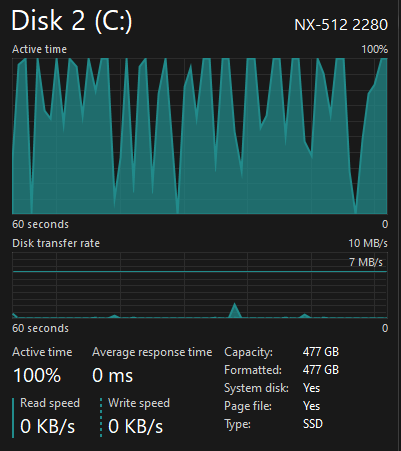this post was submitted on 14 Aug 2023
39 points (95.3% liked)
PC Master Race
14934 readers
1 users here now
A community for PC Master Race.
Rules:
- No bigotry: Including racism, sexism, homophobia, transphobia, or xenophobia. Code of Conduct.
- Be respectful. Everyone should feel welcome here.
- No NSFW content.
- No Ads / Spamming.
- Be thoughtful and helpful: even with ‘stupid’ questions. The world won’t be made better or worse by snarky comments schooling naive newcomers on Lemmy.
Notes:
- PCMR Community Name - Our Response and the Survey
founded 1 year ago
MODERATORS
you are viewing a single comment's thread
view the rest of the comments
view the rest of the comments

Huh... For troubleshooting, would you be able to boot into something other than Windows and see if the problem persists?
Unfortunately, I have no other OS on this drive. Only Windows 11. I have narrowed down the problem to a insanely high Response Time on Resource Monitor (up to 2000ms). It is usually the "System" process that is having this high Response Time. Any way of fixing or at least knowing the root cause of this?
You can easily use a boot stick with ubuntu and thats it. If you have a second pc, download the ubuntu iso and balena etcher and make a stick. It has live boot as default so you can use ubuntu on that machine without changing your harddrive. From there you can access the internet and you could download a malware scan for windows (i suppose) that can not be tricked since the malware is not installed on the ubuntu os. I hope this helps.
Getting a second OS on that drive is doable, but I mean, I find it a headache sometimes, not sure about other people. But if you've got a spare flash drive, you can live boot into some free distro to run some tests.
But, sorry, no idea what the root cause of it might be. Last time I saw something like this was when I had a Windows 8 laptop that got an update to Windows 10 and I got hit with a rare bug that apparently only occurred in some Windows 8 laptops that updated to Windows 10 where my boot drive (an HDD) would be constantly at 100% read/write without actually reading or writing anything. But it was sure trying to. There were about seven potential solutions for that and none of them worked for me. I ended up just mostly ditching the laptop as it had other issues as well, like a failing WiFi adapter somehow.
That 100% disk usage problem was definitely not rare. I had this issue with almost everything Windows 10 computer using an HDD as the system drive.
Dude, this same thing happened to me. The "System" would just go apeahit after awhile and slow everything down. A refresh Windows install actually fixed a lot of problems that I was apparently having issues with.
Unfortunately, I did a fresh install of Windows but it did not work.